Farming is a form of art. Anyone with a greenhouse can tell you that. You need green fingers and technology to meet an array of challenges. Arie Boers knows that all too well. He owns Bon Tera, a cultivation company on Bonaire. This farmer's son has to deal with slightly different growing conditions from those in Europe.

Pythium
It's always hot on this island in the Caribbean. So, Pythium is a constant threat. And cucumbers are especially susceptible to this parasite, says Arie. "We therefore deliberately use tap water, which is clean, purified seawater. We also grow on coconut fiber. The mats don't last as long here as in the Netherlands. But we compensate by planting things like herbs after the cucumbers. They're less sensitive."
Whiteflies
Whiteflies are another challenge. Bon Tera has an open greenhouse, so they can't use natural enemies willy-nilly. There's also the question of how these insects will do under shade cloth. "If this proves successful in combatting them, it can be used more widely on the island. That's provided the horticultural sector expands here," says Arie.
How does he fight these flies? The farm currently works a lot with glue ribbons, says Arie. "We use four ribbons per truss, right from the start. In the Netherlands, these ribbons function as indicators. Here we use them to catch the flies. They're, therefore, controlling mechanisms." Arie uses pesticides too, so these ribbons are mostly preventative. Per hundred meters, they easily trap a few million whiteflies.
The hot weather means these flies have very short life spans. Combine that with cucumber - these insects multiply very quickly on these - and you have an explosive mix. "So you have to always keep on top of things. Sometimes it gets so out of hand we have to clear the crop. That could be in the center of the greenhouse. That's why we've had to erect little walls. It doesn't solve everything, but it does help keep these pests a little at bay."
Arie hasn't introduced any organic pest controllers in the greenhouse. Mother Nature, however, lends a bit of a hand. Creatures like parasitic wasps are endemic to Bonaire. They sometimes grab a bit to eat in the greenhouse. Delphastus also pop in from time to time, snatching up a few whiteflies. Although, these usually only show up once the whitefly infestation is already well advanced.

Mites
There's a final problem - red spider mites. "Bonaire has the perfect conditions for these creatures to grow in. The consistently high temperature ensures short cycles. And these mites like dry, windy places. That's why we have closed much of the greenhouse off on its windy side," Arie concludes. That seems to have made all the difference. Arie has had far fewer problems with spider mites in the greenhouse since then.
For more information:
Arie Boers
Bon Tera Bonaire
Email: info@bontera.nl
Facebook page
